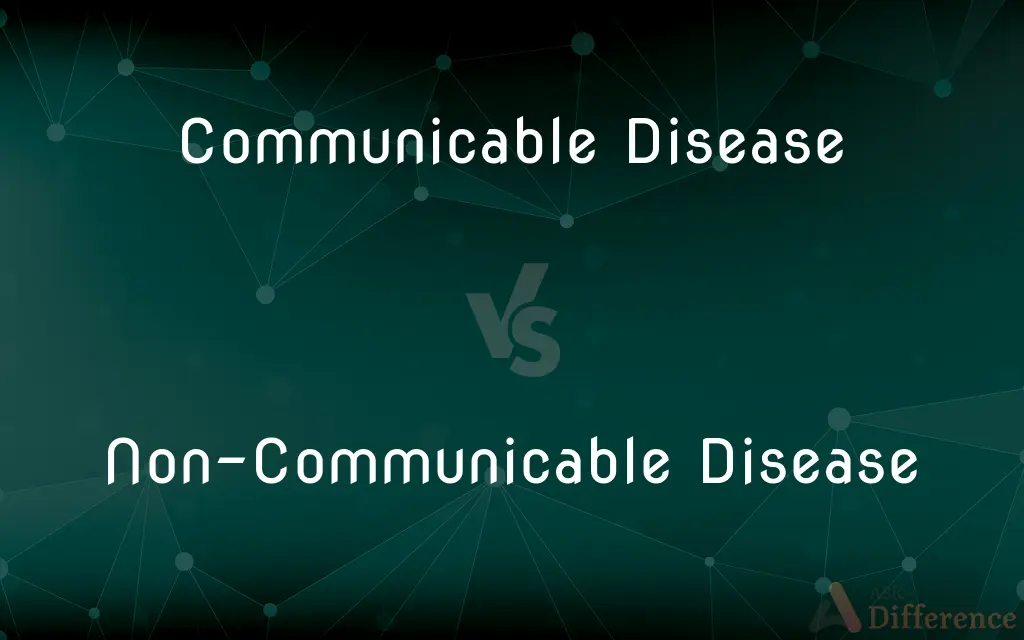Communicable Disease vs. Non-Communicable Disease — What's the Difference?
By Urooj Arif & Fiza Rafique — Published on August 8, 2024
Communicable diseases are caused by pathogens and can spread from person to person, such as influenza. Non-communicable diseases are not infectious and include conditions like diabetes, largely influenced by genetic, environmental, and lifestyle factors.

Difference Between Communicable Disease and Non-Communicable Disease
Table of Contents
ADVERTISEMENT
Key Differences
Communicable diseases, also known as infectious diseases, are caused by microorganisms such as bacteria, viruses, parasites, and fungi that can be transmitted directly or indirectly from one person to another. Examples include the flu, HIV, and tuberculosis. These diseases can spread through air, water, food, or physical contact, highlighting the importance of public health interventions to control their spread.
Non-communicable diseases (NCDs), on the other hand, cannot be transmitted from person to person. They are typically chronic conditions with long duration and generally slow progression. NCDs include heart disease, stroke, cancer, and diabetes, which are primarily caused by a combination of genetic, physiological, environmental, and behavioral factors. Unlike communicable diseases, NCDs are often preventable through lifestyle changes such as diet and exercise.
The impact of communicable diseases is often immediate and can lead to epidemics or pandemics, requiring urgent and coordinated public health responses. Vaccination, hygiene, and sanitation are critical in preventing their spread. In contrast, NCDs require long-term health system strategies, including prevention, early detection, and management of conditions to reduce mortality and morbidity rates.
Economically, communicable diseases can cause sudden and severe impacts on societies, particularly in cases of outbreaks that disrupt travel, trade, and productivity. NCDs contribute to a significant economic burden as well, due to their long-term healthcare costs and loss of workforce productivity over time.
Public health policies for communicable diseases focus on surveillance, vaccination programs, and outbreak response. For NCDs, policies aim at promoting healthier lifestyles, reducing exposure to risk factors, and improving access to healthcare services to manage the diseases and their complications.
ADVERTISEMENT
Comparison Chart
Cause
Pathogens (bacteria, viruses)
Genetic, environmental, lifestyle factors
Transmission
Person to person, through air, water, etc.
Cannot be transmitted between people
Examples
Influenza, HIV, tuberculosis
Diabetes, heart disease, cancer
Prevention
Vaccination, hygiene, sanitation
Lifestyle changes, reducing risk factors
Impact
Immediate, can lead to epidemics
Long-term, chronic conditions
Compare with Definitions
Communicable Disease
Impacted by environmental and social factors.
Overcrowded living conditions can accelerate the spread of communicable diseases.
Non-Communicable Disease
Leading cause of global morbidity and mortality.
Heart disease is the leading non-communicable disease causing death worldwide.
Communicable Disease
Diseases caused by pathogens that can spread from person to person.
Influenza is a highly communicable disease that affects millions annually.
Non-Communicable Disease
Managed through long-term healthcare strategies.
Managing non-communicable diseases often involves lifestyle changes and medication.
Communicable Disease
Can lead to outbreaks and require public health intervention.
The Ebola outbreak required extensive international public health efforts to control.
Non-Communicable Disease
Chronic diseases not caused by infectious agents.
Type 2 diabetes is a non-communicable disease with increasing prevalence.
Communicable Disease
Requires surveillance and reporting for control.
Health authorities track communicable diseases like measles to contain outbreaks.
Non-Communicable Disease
Influenced by genetic and lifestyle factors.
Smoking is a major risk factor for many non-communicable diseases, including lung cancer.
Communicable Disease
Preventable through vaccines and hygiene practices.
Regular handwashing can prevent the spread of many communicable diseases.
Non-Communicable Disease
Economic burden due to long-term care needs.
Non-communicable diseases contribute to high healthcare costs over an individual's lifetime.
Common Curiosities
Can non-communicable diseases be prevented?
Yes, many NCDs can be prevented through lifestyle changes and managing risk factors.
Why are non-communicable diseases a global concern?
NCDs are a concern due to their long-term impact on health, quality of life, and the economic burden on healthcare systems.
What are common prevention strategies for communicable diseases?
Vaccination, practicing good hygiene, and proper sanitation are effective strategies.
Can communicable diseases become non-communicable?
No, communicable diseases always involve pathogens that can spread, while NCDs are related to genetic, environmental, and lifestyle factors.
How can communities reduce the spread of communicable diseases?
Through public health measures like vaccination programs, sanitation improvements, and education on hygiene practices.
What is the key difference between communicable and non-communicable diseases?
The key difference is that communicable diseases can be transmitted from person to person, while non-communicable diseases cannot.
How are communicable diseases spread?
They can spread through air, water, food, or physical contact with an infected person or surface.
Are vaccines available for all communicable diseases?
Vaccines are available for many but not all communicable diseases. Research continues to develop new vaccines.
What is the economic impact of non-communicable diseases?
NCDs have a substantial economic impact due to long-term healthcare costs and loss of productivity.
Can communicable diseases be eradicated?
Some can be eradicated with effective vaccination and public health strategies, as seen with smallpox.
Can climate change affect the spread of communicable diseases?
Yes, climate change can influence the distribution of diseases, especially those transmitted through vectors like mosquitoes.
Is there a link between communicable and non-communicable diseases?
Yes, individuals with NCDs may have increased susceptibility to communicable diseases due to weakened immune systems.
What role does lifestyle play in non-communicable diseases?
Lifestyle factors like diet, physical activity, and tobacco use significantly influence the risk of developing NCDs.
How do public health policies differ for these disease types?
Policies for communicable diseases focus on prevention and control of spread, while for NCDs, they focus on prevention through lifestyle changes and healthcare access.
What is the significance of early detection in non-communicable diseases?
Early detection can lead to more effective management and treatment, reducing the impact and progression of the disease.
Share Your Discovery

Previous Comparison
Wind Power vs. Hydropower
Next Comparison
Photo vs. PhotocopyAuthor Spotlight
Written by
Urooj ArifUrooj is a skilled content writer at Ask Difference, known for her exceptional ability to simplify complex topics into engaging and informative content. With a passion for research and a flair for clear, concise writing, she consistently delivers articles that resonate with our diverse audience.
Co-written by
Fiza RafiqueFiza Rafique is a skilled content writer at AskDifference.com, where she meticulously refines and enhances written pieces. Drawing from her vast editorial expertise, Fiza ensures clarity, accuracy, and precision in every article. Passionate about language, she continually seeks to elevate the quality of content for readers worldwide.













































